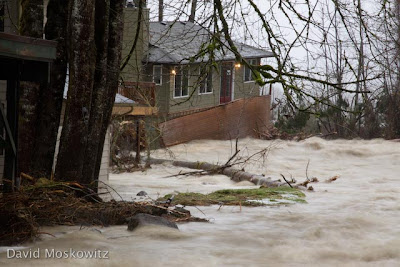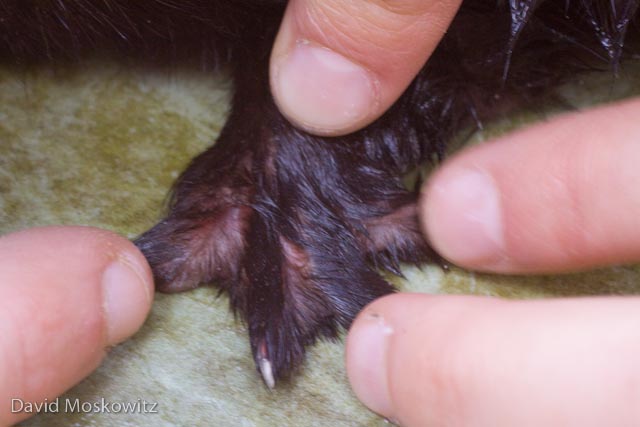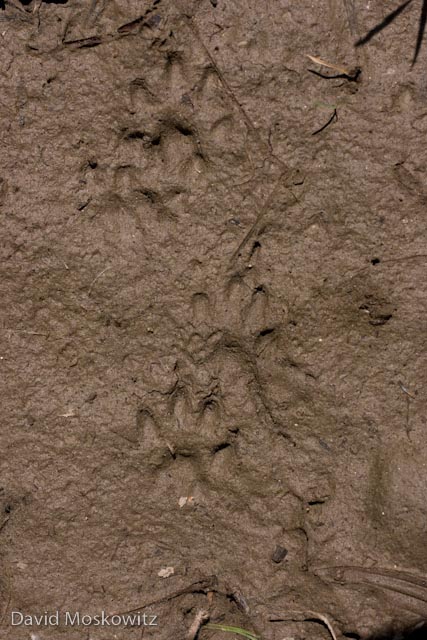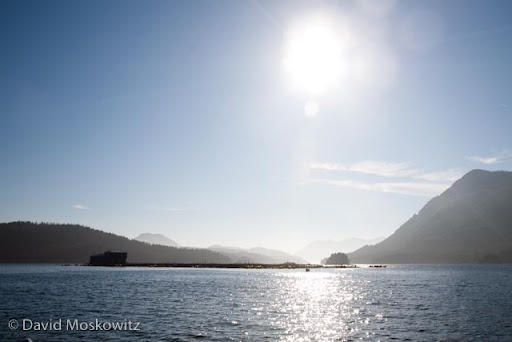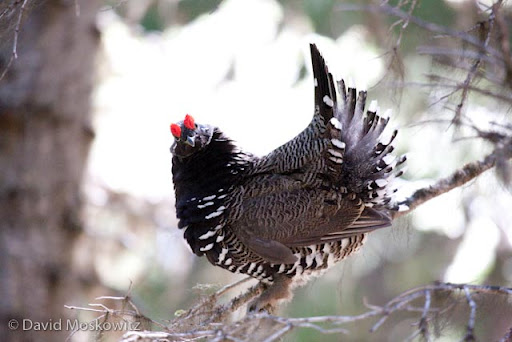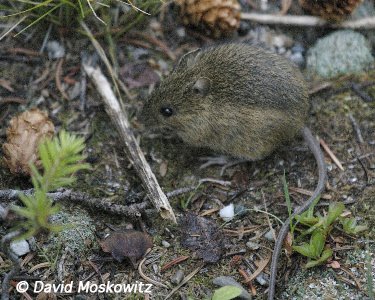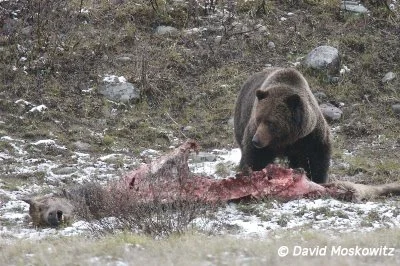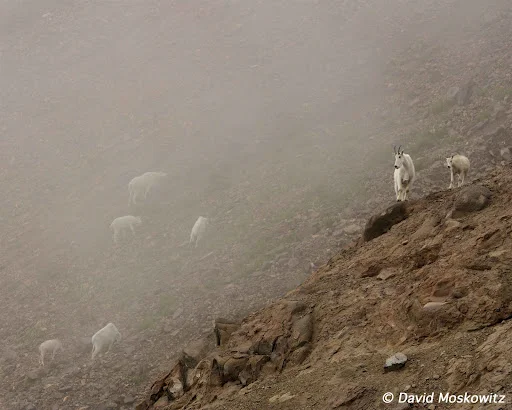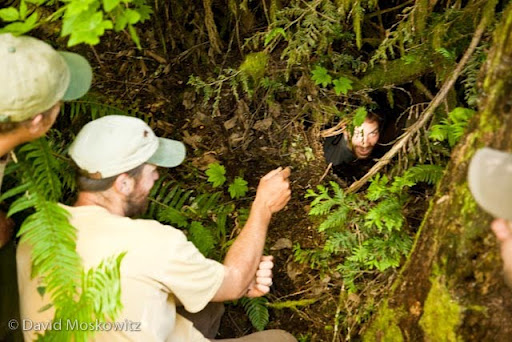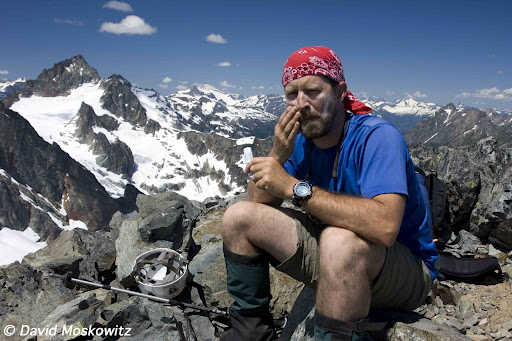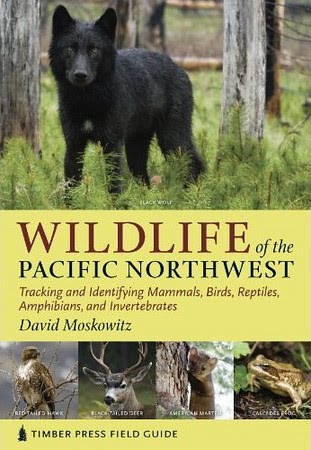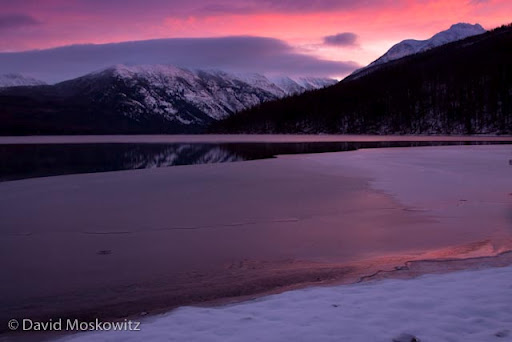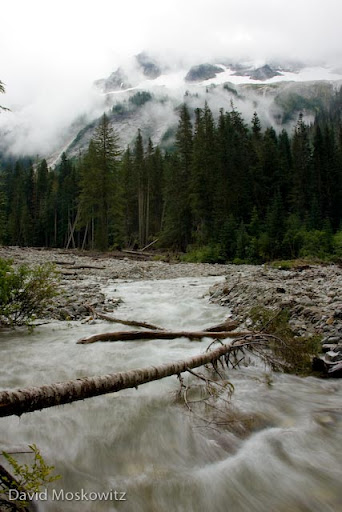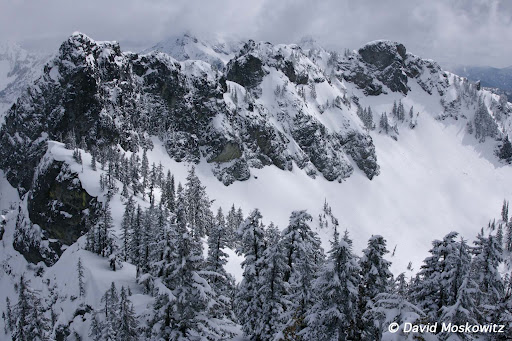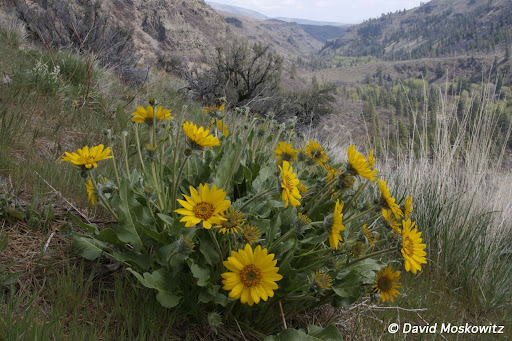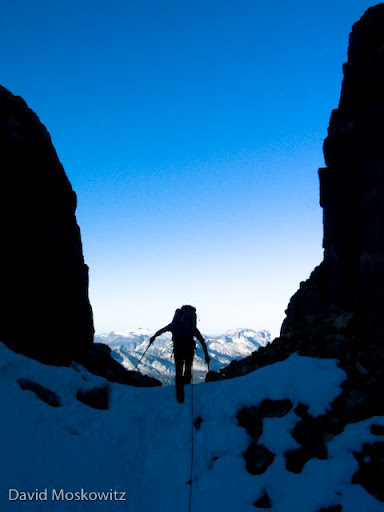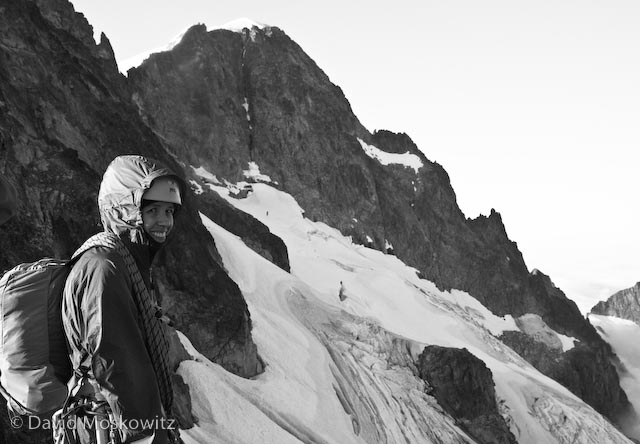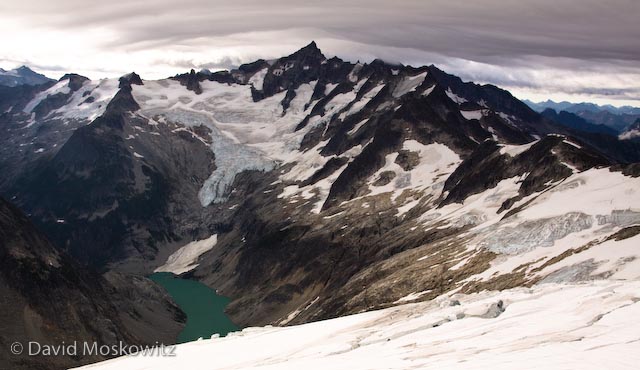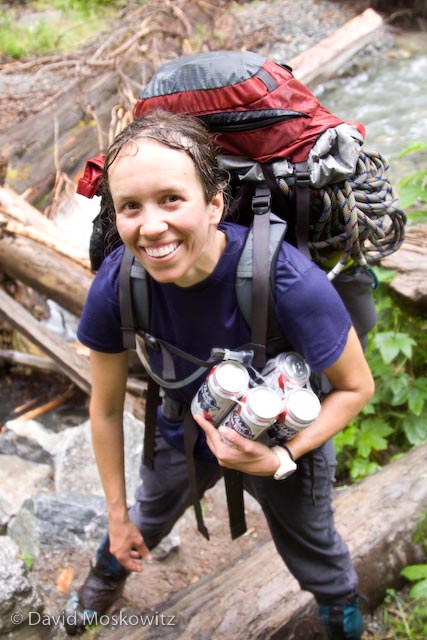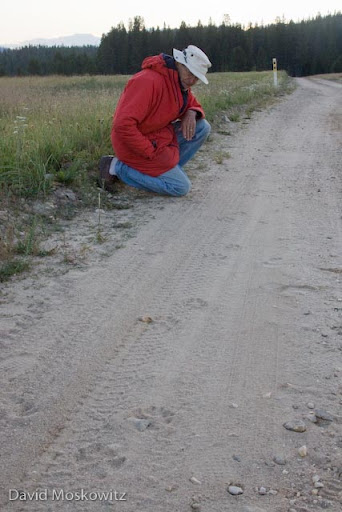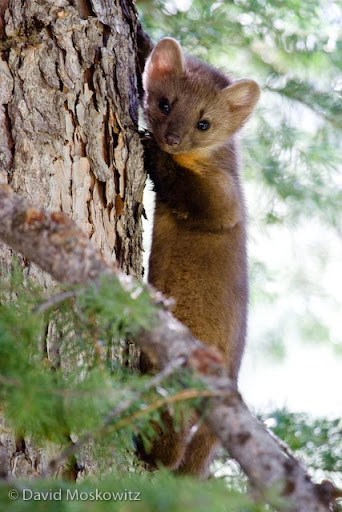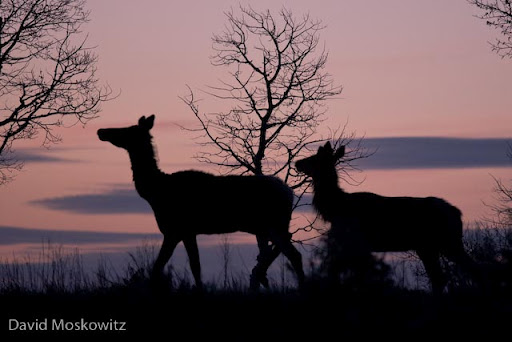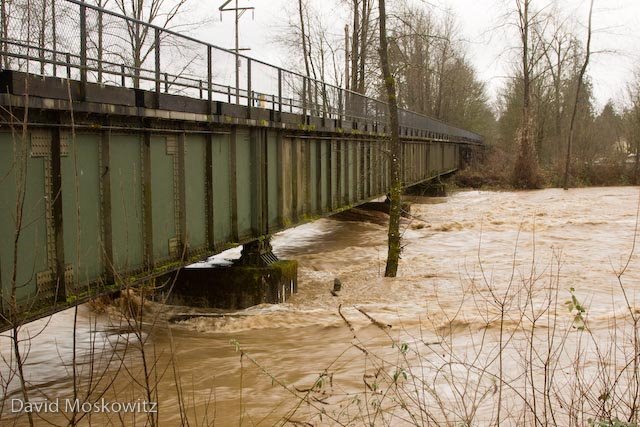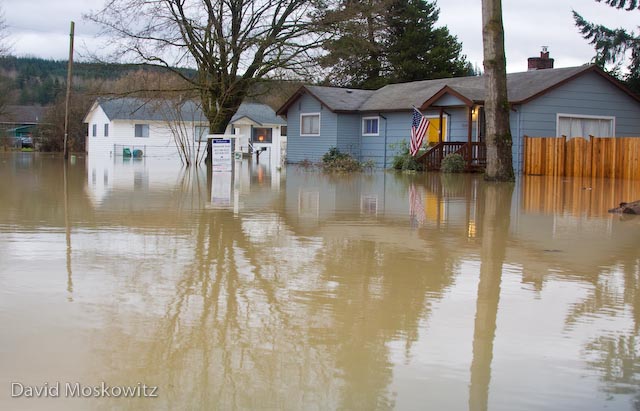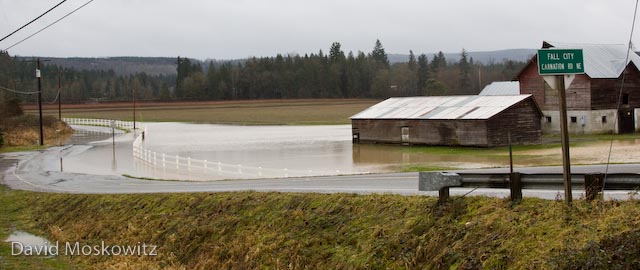Do mink (Neovison vison) have webbed feet?
Left front foot.
While researching and writing my field guide I encountered various published accounts of the foot structure of mink (Neovison vison). Because of these discrepancies I sought out specimens to examine personally. I examined the feet of 3 recently deceased mink, all from western Washington as well as about a dozen museum skins at the Burke Museum at the University of Washington. All of the green specimins I examined showed mesial webbing on both front and hind feet. Some of the museum skins did as well, while others where dried in such a way so as to make analysis of this impossible. None of the green specimins or museum skins were clearly lacking webbing between toes. The amount of webbing is slightly less than in their larger cousins, river otters (Lutra canadensis) but is none the less quite clear. As is typical with the tracks of most web-footed animals, webbing can be detected in footprints in deep substrates but is often not apparent where substrate is firmer.The photos of actual feet bellow are from a male mink which was killed by a vehicle in the Snoqualmie River Valley, King County, Washington in 2009.
Left front foot with toes splayed showing mesial webbing between toes.
Hind feet.
Toes splayed on hind foot revealing webbing.
Top view of a hind foot also showing webbing.
All four tracks of a mink in a typical loping pattern for the species. In this deep substrate the webbing between the toes has registered. Tracks from along the Snohomish River, Snohomish County, Washington.
Closer view of two tracks (left hind on top of left front) from the same set of tracks as above.
Tracks a small (likely female) mink from along the Yakima River in Kittatas County, Washington, also in a typical loping pattern. In this firmer substrate the mesial webbing has not registered.
Clayoquot Sound Revisited
A week of journeying by land and sea has yielded some great results as I continue to collect material for my forthcoming book on Wolves of the Pacific Northwest. I am tremendously grateful to Steve and Susanne Lawson for their invaluable assistance in my fieldwork here in Clayoquot Sound thus far! Stay tuned for more photos and stories to come!
Sea Otter patrolling coastal waters north of Ucluelet.
The return of extensive bull kelp forests along the northern Pacific coast has been associated with rebounding Sea otter populations, a classic example of a trophic cascade. Bull kelp was released from heavy browsing pressure by sea urchins with the return of otters which love to eat urchins.
Rocky coastline close to Wye Point, north of the town of Ucluelet
Guess the beach brings out the playful side of more than just juvenial people. Here two yearling wolves play with washed up seaweed on an island in Clayoquot Sound.
Wolf crossing a lead of water at first light.
We watched this randy male black bear following a smaller female bear earnestly, stopping only to rub vigorous on a large drift wood log, a behavior which increases during the breeding season.
Oystercatchers are one of the most common shorebirds in the Sound this time of year.
Freeloading Chicken Update

"Dave- I checked the White Pine camera on Sunday the 20th after two weeks, got about 640 shots of a Pine Marten, two grey jays, and a few wind triggers. I replaced the batteries, card, bait and scent. It only took that Marten two days to get all the bait."--Pete Jenkins
The Curious Case of the Freeloading Chicken and the Wolverine
This weekend, following up on several sets of likely wolverine tracks biologist and backcountry skier Pete Jenkins discovered, a small group of intrepid citizen scientists set out to place a remote camera in the vicinity in hopes of capturing a photo of the illusive carnivore. Grey skies and a very thin coat of fresh snow beckoned.Clouds covered the high peaks of the Chiwakum mountains south of Highway 2 in the Washington Cascades when the group met early Saturday morning. For the project, a few unusual items were called for, not usually included in the field kit of backcountry skiers: a hammer, some chicken wire, a motion sensitive camera, and, much to my chagrin, a frozen chicken and the contents of the scent glands of a beaver (these two items ended up in the bottom of my backpack). More typical of such a ski trip, Samantha Goff insisted on the addition of a can of Pabst Blue Ribbon Beer to each of our packs (see my blog post on climbing around the Eldorado Massive, http://davidmoskowitz.blogspot.com/2009/08/climbing-in-north-cascades.html, for background on Sam and PBR).We departed bright eyed and bushy tailed as heavy wet snow fell, providing some reprieve from the hard raincrust. A couple of hours later, a gain of 2000' elevation, skinning on an old logging road and then up through uncut mixed conifer forest, had left us quite wet and me feeling a bit upset about the freeloading chicken weighing me down.Pete identified the location he had determined would be the best spot to set up the camera based on prievious track sightings and how animals general moved across this particular set of drainages descending from a large alpine cirque above. Not a minute too soon. I was totally fed up with my chicken (and had a sneaking suspicion it might be leaking chicken juice into my pack.
Writer Chase Edwards (http://poboxtheeurovan.blogspot.com/) looks on nervously as Pete attaches the bird to the tree.
Pete attaching the chicken, wrapped in chicken wire, securely to the bait tree with remote camera in background.
Chase unwrapping the strong smelling scent lure.
Chase, clearly relishing the opportunity to smear the bait tree with beaver castorum, an irresistible scent for many creatures.
Chase and Sam celebrating a job well done. Much of the skiing that followed, while punctuated by (brief moments of) fine turns, might otherwise be described much like dancing with a partially frozen chicken across a floor of slide alders, avalanche debris, and thinly covered raincrust. Stay tuned here for photos we get from the camera!
Seattle Times Article
American marten (Martes americana) track in snow.
Seattle Times Article on wildlife tracking in snow, and the Cascade Citizen Wildlife Monitoring Project.Check it out! Animal trackers read dramas in the snow by Kathryn True. November 17, 2010.
Bears, for a change of pace
Black Bear feeding on huckleberries. East of Heart Lake, Olympic National Park
A few images from a recent trip to the 7 Lakes Basin in Olympic National Park.
Black bear, Olympic National Park.
Black bear, Olympic National Park.
Darcy Ottey with the Hoh River Valley and Mt. Olympus in the background.
Darcy Ottey watching a bear feed in the meadow beyond her. An Olympic marmot was also watching the bear with much scrutiny. West of Swimming Bear Lake, Olympic National Park.
Western Heather Vole (Phenacomys intermedius). Lunch Lake, Olympic National Park.
Stream in the Sol Duc River Valley, Olympic National Park.
Black bear, feeding on huckleberries. Olympic National Park.
Clayoquot Sound, B.C.
Wolf tracks along west coast of Vancouver Island, British Columbia.
Bald eagle above a foggy forest.
Carcass of juvenile humpback whale on beach of island in Clayoquot Sound
Racoon foraging for sand flees on beach of island in Sound
Black-tailed deer feeding on seaweed on island in Clayoquot Sound.
River otter scent marking on seaweed as tide goes out.
Black bear foraging for invertebrates in the intertidal zone by rolling rocks.
Large Sitka spruce in ancient forest on island in the Sound.
A gray wolf trots along the beach early in the morning with ravens in the background. West Coast, Vancouver Island.
Tofino Inlet, Clayoquot Sound.
Harbor seals lounging at low tide.
Atlantic salmon fish farm in Clayoquot Sound with uncut forest in background. Several rivers with no clearcuts or roads in them are seeing massive declines in salmon numbers due to sea lice and other issues associated with fish farming in the Sound. The smell is overwhelming, far worse than a dairy farm and totally shocking in such a wild setting.
Active clearcut logging in Clayquot Sound. Top of the photo is uncut oldgrowth. Bottom is regrowth from a previous clearcut.
Growth rings: over 200. Destination: ?
Huge western red ceder stump set amidst second growth forest of planted Douglas firs. Note that the original nurse log that the ceder tree started growing on in still under the stump, attesting to the volume of biomass in the previous ancient forest and the literally centuries it took to create the structural diversity so important to many Old growth obligate species.
Despite decades of conservation efforts, Clayoquot Sound, a UNESCO Biosphere Reserve, faces numerous severe threats to its ecological integrity including clear cut logging of roadless old growth forests, industrial Atlantic salmon fish farms, and proposed open-pit copper mining. Learn more about the region and how you can support conservation in the region at the following websites:Friends of Clayoquot Sound Clayoquot Biosphere Reserve First Nations Environmental Network
WILDLIFE
Western heather vole (Phenacomys intermedius). Olympic National Park, Washington.
Winter Wren with insects in its mouth bound for hungry young. Western Washington.
Black bear.Olympic National Park, Washington Wilderness, North Cascades, Washington
Male Franklin’s spruce grouse. North Cascades, Washington
Black-tailed Deer BuckKlamath Mountains. Northwestern California
Western Grey Squirrel feeding on acorns in an oak tree. Klamath Mountains. Southwestern Oregon
Western Jumping MouseSelkirk Mountains, southeastern British Columbia
Grizzly Bear on Elk carcass. North Fork Flathead River, northwestern Montana.
Bull Moose. Northeast Washington.
Mountain goats in mist. Goat Rocks Wilderness, Washington Cascades.
Bighorn Sheep Ram. Clemens Mountain, East slope Washington Cascades.
Great Egret. Bolinas Lagoon, Northern California.
Northwest People
Outward Bound Instructor Jacob Anderson climbing the Horsefly couloire on Reynolds Peak, Sawtooth Range, North Cascades, Washingtion.
Naturalist Marcus Reynerson inspects a black bear den discovered by David Scott who looks on along with Gabe Spence and Brian McConnell. Western Washington.
Climbing guide Forest McBrian shows off some stylin’ moves. Bellingham, Washington.
A taste of winter for Emily Gibson.Washington Cascades.
Casey McFarland prepares goose feathers for photographing for his forthcoming text on Bird Feathers of North America (co-author David Scott). Redmond, Washington.
Naturalist Emily Gibson inspects a marsh wren nest she discovered. Potholes, WA
Darcy Ottey on a sunny fall day in the Cascades
Rosa Levin taking a photograph,North Cascades, Washington
Mountaineer Steve Smith applies sunscreen on a bright day.Ragged Ridge, North Cascades Washington.
Forest McBrian reflects on life and love. Nisqually Wildlife Refuge, Puget Sound Washington.
Bling Bling takes a well earned rest bellow High pass. Glacier Peak Wilderness, Washington.
Drawing badger tracks from a plaster cast.Vashon Island, Washington.
Wildlife of the Pacific Northwest
WILDLIFE OF THE PACIFIC NORTHWEST Tracking and Identifying Mammals, Birds, Reptiles, Amphibians, and Invertebrates
written, photographed, and illustrated byDAVID MOSKOWITZ
A TIMBER PRESSS FIELD GUIDE
SCHEDULED FOR RELEASE ON APRIL 28, 2010
Now available. Purchase your copy through www.davidmoskowitz.net and support the author and the educational mission of Wilderness Awareness School!
Wild animals fascinate, yet are rarely seen. It is possible, though — if you know what to look for and where, and if you understand what you see — to increase your chances of wildlife sightings, whether you are far from civilization or right in your own backyard. Wildlife of the Pacific Northwest includes illustrated descriptions for more than 180 mammals, birds, reptiles, amphibians, and invertebrates most common in Washington, Oregon, British Columbia, northern California, Idaho, and western Montana. With more than 460 photographs, hundreds of scale drawings, and more than 90 distribution maps, it belongs in every pack and is a must-have for nature lovers of all ages and skill levels.
David Moskowitz, a professional wildlife tracker, photographer, and outdoor educator, has been studying wildlife and tracking in the Pacific Northwest since 1995. He has contributed his technical expertise to a wide variety of wildlife studies regionally and in the Canadian and U.S. Rocky mountains, focusing on using tracking and other non-invasive methods to study wildlife ecology and promote conservation. David has worked on projects studying rare forest carnivores, wolves, elk, Caspian terns, desert plant ecology, and trophic cascades. He helped establish the Cascade Citizens Wildlife Monitoring Project, a citizen science effort to search for and monitor rare and sensitive wildlife in the Cascades and other Northwest wildlands. David’s extensive experience as an outdoor educator includes training mountaineering instructors for Outward Bound, leading wilderness expeditions throughout the western United States and in Alaska, teaching natural history seminars, and as the lead instructor for wildlife tracking programs at Wilderness Awareness School in Duvall, Washington. David holds a bachelor’s degree in environmental studies and outdoor education from Prescott College. View his photography and find out about classes at www.davidmoskowitz.net.
Paperback Flexibind Pages: 364 pp. Images: 464 color photos, 213 line drawings and 93 mapsTracks In Snow, Winter 2009-2010
American marten (Martes americana)left hind track. North Cascades, Washington.
Gray Wolf (Canis lupus)hind track. Northern Rockies, Montana.
Mountain lion (Puma concolor)left front track. Northern Rockies, Montana.
Canada lynx (Lynx canadensis)left front below left hind tracks. Northern Rockies, Montana.
Moose (Alces alces)hind track. Northern Rockies, Montana.
PACIFIC NORTHWEST LANDSCAPES
Ponderosa pine and hoar frost.East slope Cascades, Washington
Kintla Lake.Glacier National Park, Montana
Mount Shuksan and the north fork of the Nooksack river.North Cascades, WA.
Hoar frost on snags. North Cascades, WA.
Sunrise over Mount Redoubt.North Cascades, Washington
Mountain stream west of Whatcom Pass.North Cascades, Washington.
Rogers Lake and Tiffany Peak, site of the Tripod Fire.Okanogan Highlands, north-central Washington.
Beargrass, Cornice peak. Selkirk mountains, southeastern British Columbia.
Sunrise in the Selkirk mountains, northeastern Washington
Kendell Peak ridgeline, Snoqualmie Pass, Washington Cascades
Southeastern Oregon
Balsamroot in the Tieton River Canyon. East slope Washington Cascades
Mount Baker and Mount Fury at Sunrise. North Cascades.
Northern California Coast
Pickets Traverse
Forest McBrian climbing into a col on the south side of Mount Fury.
Whatcom Peak, the northern start of the Pickets range
Challanger Glacier, the largest glacier in this part of the North Cascades
Forest McBrian hiking out of Luna Cirque with the massive north face of Mount Fury rising on the left and Luna lake below.
Southern Pickets from the north. Left to right: East McMillian Spire, West McMillian Spire, Inspiration Peak, Mount Dagenhart, Mount Terror
Forest McBrian traversing south along the ridge leading to Picket Pass, what Fred Beckey might refer to as “pleasant hiking”.
Forest on the Mustard glacier, part of our travel route over the southern Pickets.
Forest making the transition from the icy glacier to the steep wet rock which lead to the col between the Ottohorn and Himelhorn peaks and our route out of the Pickets. This section of the route was the most technically challenging piece of the entire traverse in the conditions we encountered it.
Last views to the north before we dropped down and south out of probably the most wild and remote section of the North Cascades. Mount Fury and Luna Peak in the distance.
One last major obstacle descending south off of our last col, a steep gully (an eroded volcanic dike of which there were a number in the range which presented difficulties along the traverse) filled with large quantities of loose rocks. The light at the end of the chasm couldn’t come soon enough.
Luna Peak at sunrise from the south
Climbing in the North Cascades
Samantha Goff and Matt Chalmers, filled with anticipation at the start of our trip into the Eldorado Peak high camp.
Samantha and Matt on the Inspiration Glacier on the approach to the West Arete of Eldorado Peak.
Samantha smiling at our first view of the route from the Dorado Needle Col which separates the McAlester Glacier from the Marble Creek Cirque. The climbing route is esentially the right skyline
Samantha at a belay ledge soon after getting on the arete, just above the layer of clouds which filled the Marble Creek drainage.
Happy faces after enduring an unplanned bivouac high on the west face.
Samantha looking up towards the summit as Matt leads the final pitch of the route. Dorado Needle and Early Morning Spire in the background.
Looking south from the summit across a sea of clouds with only the highest peaks of the North Cascades jutting up like islands.
Johannesburg Mountain in the foreground.
The south ridge of Eldorado Peak and the Eldorado Glacier.
Inspecting the descent off of the snow arete on the south ridge of Eldorado.
Forbidden Peak, the Forbidden Glacier and Moraine Lake with part of the Inspiration Glacier in the foreground, taken from our camp at the base of Eldorado’s east ridge.
Samantha leading out across the McAlester glacier towards Dorado Needle.
Samantha navigating the north ridge of Dorado Needle.
Myself at a belay ledge on Dorado Needle.
The massive west face of Eldorado Peak briefly poked out of the clouds while we were on Dorado Needle.
Samantha leading out on the final pitch on Dorado Needle.
Matt nearing the summit.
Matt navigating the final piece of the ridge, a knife edge section which he is climbing “au cheval”.
Samantha belaying from just below the summit.
Soaking wet from a long descent in pouring rain, Samantha completes a successful trip with the safe retrieval of several cans of Pabst Blue Ribbon beer from the Cascade River.
.
Wolf Tracking in the Salmon River Mountains, Idaho
The landscape, typical of the mountains of central Idaho shows conifer forests, dominated by lodgepole pine (Pinus contorta) in various stages of regeneration after naturally occuring fires. Interspersed are large wet and dry meadow systems.
Don Taves inspects the trail of a wolf trotting down a dirt road.
The right front foot of a large wolf. The toes have splayed widely and the claws of each digit have dug in deeply, including in the reduced inside toe due to the fast speed of this animal. The bounding trail of this wolf was adjacent to the trail of two fleeing mule deer indicating a pursuit (apparently unsuccessful for the wolf).
A pine marten (Martes americana) peers down from a safe perch.
Sandhill crane (Grus canadensis) in flight. Cranes breed and rear young in the vast wet meadow systems of central Idaho.
Columbian ground squirrels (Spermophilus columbianus) at a burrow.
Rocky mountain elk (Cervus elaphus)
Students in Wilderness Awareness School’s Idaho Wolf Tracking Expedition hiking out across Corduroy meadows at the southern end of the Frank Church River of No Return Wilderness towards the end of a long day in the field searching for and following wolf tracks and signs.
A Northern Pocket Gopher (Thomomys talpoides) Hard at Work.
The gopher had just begun to expell earth when I discovered him hard at work.
The exposed gopher quickly pushes soil out of his hole and then retreats back to a safer position to observe its surroundings.
The completed throw mound with the hole plugged at the base of it. Throw mounds are produced in the process of creating underground tunnels the pocket gopher uses for accessing food (roots and vegetation), as well as sleeping chambers, food storage spaces, and latrines.
The finished throw mound with the tent I was staying in the background.
Pocket gophers are prodigious soil movers. Though seldom seen, the throw mounds they create are conspicuous in areas they inhabit. Mounds are often confused with those produced by moles. However, as seen here, gophers produce fan shaped mounds expelling dirt from a hole to one side of the mound of soil which is plugged afterwards. Moles expel earth from a hole which come straight up out of the ground and the resulting mound of soil is generally evenly dispersed to all sides of the plugged hole when complete.I had the opportunity to photograph this creature while it worked right in the middle of where I was camped and could thus leisurely photograph and drink a cup of tea as the sun rose one May morning in Western Colorado over the course of an hour, an unusual pleasure while photographing elusive wild creatures.
Western Colorado: Aspen forests and Wildlife of the High Lonesome Ranch
Aspen stand at about 8500′ elevation on the western edge of the Rocky mountains
Aspen stand with bear climbing marks and elk cambium feeding scars on trees in the foreground. Many aspen stands in the southern Rockies are dying for reasons that are not yet totally clear. Aspen stands are generally comprised of one or a few individual organisms (called “Clones”) each of which sends up multiple trunks. About half of the mature trunks in the patch are dead.
Entrance and throw-mound of a bear den found on a steep forested northwest facing slope close to a ridge line at about 8200′ elevation.
Close up of the internal chamber of the den. The den was only about 4′ deep
Dewitt Daggett gets a close look at the den.
Rocky mountain elk at sunrise with stunted aspen in the background.
Incisor marks from an elk feeding on the bark of an aspen. Barking of aspens by elk can have extensive impacts on aspen stands. Along with the bark, elk, deer and cattle also feed on the branch tips of saplings stunting their growth and retarding recruitment of young trees where browsing pressure is intense.
A red-naped sapsucker paused from excavating a new cavity in a dead aspen tree. Cavities excavated by woodpeckers are used by a wide variety of other birds and mammals as nests once abandoned by the woodpecker.
A female Purple Martin looking out from its nest cavity in a standing dead aspen tree. In this same tree was also a nest cavity being used by a house wren.
Female and male Purple Martins courting close to their nest cavity.
Female collecting dead aspen bark to line her nest cavity.
Mule deer resting in the shade of a Douglas fir during the midday heat.
Large scrape made by a mountain lion under a large Douglas fir at along a ridge. This scrape has been visited and enlarged over repeated visits by the cat. Scrapes such as these are a scent marking behavior performed by both bobcats and cougars.
Looking northwest across the western edge of the Rocky Mountains at sunset.
Sunset and aspens
..
Wildlife Tracks and Signs
River otter trail with a slide down a short slope.North Cascades, WA
Porcupine, fast walk track pattern. Umpqua Dunes, Oregon Coast
Mountain Lion and Black-tailed Deer tracks in mud. Skagit River, Washington.
Canada lynx, walking trail wending through fresh snow. North Cascades, Washington
Pellets of 3 Pacific Northwest Lagomorphs:Black-tailed jackrabbit (left), Nuttal’s cottontail (center), Pygmy rabbit (right) Southeastern Oregon.
Black bear claw marks on a Ponderosa pine tree. Northwestern Montana.
Northern River Otter. Right hind foot. Puget Sound, Washington
Coyote tracks, front (bellow) and hind (above). Oregon Coast.
.
Global Climate Change Comes to Carnation Washington
Under the old railroad trestle bridge over the Tolt River, WA.
Same location as above during typical winter stream flow.
Tolt river from same location as above during typical winter stream flow.
Tolt River, flood stage.
Tolt River from the similar vantage, typical winter stream flow.
Tolt river at flood stage.
Tolt river photographed from close to the same location as photo above during typical winter stream flow.
A new addition to Carnation. This entirely new log jam is about about 300 metres long and and 40 feet wide or wider in places, at the confluence of the Snoqualmie and Tolt rivers. It has completely obliterated a two lane gravel road that ran along the edge of the river here.
Looking north on Highway 203 just north of Carnation, WA
Flooded farm in the Snoqualmie Valley, WA.
Flooded house for sale. Carnation, WA
Flooded neighborhood in Carnation, WA.
Carnation Tree Farm, WA
Highway 203, just south of downtown Carnation, WA.
Flooded farm field south of Carnation caused by a burst levee on the Tolt River.
Highway 203 in Carnation, WA
